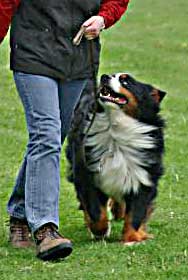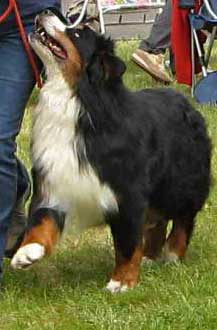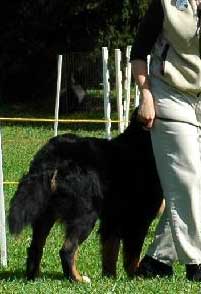Basic Obedience Instruction
.......................Teaching Hello, Heeling
By Vilma Kistner Briggs, M.D.
So you think you might want to put a few obedience titles on your Berner? Great! What do you think is the hardest exercise to teach? Is it those amazing out-of-sight, sit and down stays, the mysterious scent discrimination tasks, or that silent signal exercise in Utility, 50 feet away from the dog? No. The hardest exercise to teach - and teach well - is teaching your dog to heel!
Poetry in Motion versus Where Did He Go?
Watching a good dog/handler team heel together is really like watching a dance. It is pure art in motion: the subtle cues to which the dog responds, the teamwork needed to maintain a perfect position as two beings move as one. It can be a beautiful thing.
At the other end of the extreme is what often happens the first time the leash comes off your dog in Novice obedience class - an embarrassing disaster! The poor dog completely loses all interest in Mom and wanders around the ring, sometimes following several feet behind the increasingly distraught handler. In some cases, the handler is no longer in view of the dog because he is busy checking out the sexy Poodles in the next ring or the kid dangling his hot dog over the ring gating. We have all experienced it and know that it is very lonely heeling alone in the middle of a very large ring with the world looking on.
Learning the Heeling Dance
So how do heeling teams develop teamwork and learn the "dance" that is heeling? There are many methods that can work well, but most of them are variations on the same basic idea. Let me explain what has worked for me when I am working with a new dog learning basic heeling. This is how we learn the concept of working together, the concept of the dance.
What I am about to explain is how to get started on straight-line heeling, introducing the dog to the concept of maintaining the correct position at my left side, with active attention and eager focus. The other maneuvers of the heeling exercise must be taught as the individual skills that they are - before being incorporated into the rest of heeling: halt/sit, fast, slow, left turn, right turn, about turn.
Before we discuss specifics, let's begin by reviewing how the AKC defines heel position in its Obedience Regulations (p.18):
"The dog should be at the handler's left side straight in line with the direction the handler is facing. The area from the dog's head to shoulder is to be in line with the handler's left hip. The dog should be close to, but not crowding, its handler so that the handler has freedom of motion at all times."
Introduction to Hello Heel Position - Luring
 I train my dogs to heel by using a food lure. In my experience using a food lure is the fastest, most efficient, humane, and simplest method. It will also hold up for long-term showing and campaigning if done properly with a solid foundation and when the dog is not taken into the ring too early.
I train my dogs to heel by using a food lure. In my experience using a food lure is the fastest, most efficient, humane, and simplest method. It will also hold up for long-term showing and campaigning if done properly with a solid foundation and when the dog is not taken into the ring too early.
The visible food lure is used to show the new dog the correct behavior that I want from him (i.e., trot along at my left side in heel position). Similar to how I train sit and down, I use the treat as a "magnet" for his nose - where the cookie goes, the nose goes, and where the nose goes the rest of the body cannot be far behind! The lure keeps the dog in the position where I want him to be.
I hold the large, visible, tasty treat right above his nose in my left hand, with my hand next to my left hip to position his head exactly where I want it. I start by taking only one step forward. The dog must keep his head up and his eyes on that cookie. If he does that, then he gets the cookie and I release him. I repeat this sequence until he can come off the sit with his head up looking at the cookie reliably. Next, I increase the difficulty by asking him to take two steps with me before he gets the cookie. Then three, then back down to one, then three again. Please do not go from two steps to eight! That is unfair to the dog and he will end up dropping his head. Remember, your dog is not heeling if he is not looking at you. If your dog is looking at the ground, he is not heeling correctly. If that happens, one must stop immediately and make it easier for him to do the right thing.
Next, I hide the food from sight by holding it in my left fist at my left hipbone, close to my body. Over the next few weeks and months, the treat is gradually taken away. Do not remove the treat too soon or your dog will be confused and bored. Before removing the treat, the dog must understand that he is to keep himself in a certain spot next to me, while maintaining attention on his focal point. The focal point can be my left hand or hip, or my face, or left knee, depending on the dog's structure and size. At this point of his understanding, my cookie transforms from being a lure for moving him into the correct position, to being a reward for being in position.
When the treat is being used as a lure it is being used to show or teach the dog a new behavior. It is held in my left hand. When the dog has demonstrated that he understands what is expected, the treat is used as a reward when the dog performs the learned desired behavior. At that point, the treat is not visible to the dog. Although the treats (or toy) is out of sight, the dog knows that it is still accessible to him if he executes the desired behavior. It is important to wean the dog off the treat/toy or it would become a bribe rather than a reward. One should avoid inadvertently letting this happen.
Shaping -- or How to Catch Up if He Gets Lost!
The second part of teaching heeling is to SHAPE the behavior, so called "free shaping" or "pure shaping." In shaping one does nothing to create or force the behavior, but instead waits for the dog to offer very small increments of the desired behavior on his own. The handler marks the behavior with a clicker, giving a treat (reward.) Over time, the trainer requires more and more from the dog before the reward is given, until the desired behavior is established.
 I use shaping to teach behaviors such as dumbbell/glove retrieve, target touch and tricks (e.g., sit up, wave). This method is explained in Choose to Heel by Dawn Jecs (http://www.choosetoheel.com/). It is an older book but very good at explaining how to teach heeling using shaping only. (I attended a half-day seminar where she demonstrated heeling with a potbellied pig that she had trained.)
I use shaping to teach behaviors such as dumbbell/glove retrieve, target touch and tricks (e.g., sit up, wave). This method is explained in Choose to Heel by Dawn Jecs (http://www.choosetoheel.com/). It is an older book but very good at explaining how to teach heeling using shaping only. (I attended a half-day seminar where she demonstrated heeling with a potbellied pig that she had trained.)

Begin with a hungry dog that is off-leash in a safe enclosed area where you are the most interesting thing in the area. A ring about half the size of an obedience ring is a good size. Say nothing and give no commands. Start walking briskly around the ring, standing up straight as if you are heeling with an invisible dog. Walk around briskly in straight lines and in wide arcs and circles to left and right. Do not make sharp turns (i.e., do not make any about turns or left or right turns) as you would in a standard obedience ring. You should have very tasty, smelly, wonderful treats in your left fist. Good treats for this include baked liver, garlic hot dogs, pep-peroni, roast beef, or sharp cheddar cheese. Do not try this right after a meal because you want your dog to be highly motivated by the treats (and his hunger).
If you are shaping, I assume the dog already knows that the clicker marks the correct behavior and means a tasty treat is on the way. When you click, it is like taking a photograph - it captures the dog executing the correct or desired behavior, so timing of the click is very important.
Hold your clicker in your right hand. Briskly heel around the ring, by yourself, in big circles. As you start to get lonely and your dog begins to tire from sniffing the floor and wandering over the general vicinity near you, say nothing. Smile and click as you hand him a tasty treat. Immediately turn around and begin walking the other way. Eventually he should begin to wander over in your vicinity. Again, click and treat, turn and walk away briskly.
 Eventually you will start increasing your criteria for reinforcement, only clicking and treating when he is near your left side, then only when he is in perfect heel position for one step, then only when he maintains position for a couple of steps and finally when he heels a couple more steps.
Eventually you will start increasing your criteria for reinforcement, only clicking and treating when he is near your left side, then only when he is in perfect heel position for one step, then only when he maintains position for a couple of steps and finally when he heels a couple more steps.
Each time that you click-treat, you turn and walk briskly away again from him, pretending that you are trying to get away, so that he must fight to catch up to stay in heel position. Make him work to get into that "sweet spot"!
I don't use pure shaping exclusively to teach heeling, rather I like to do some shaping work with all of my dogs. Generally, I use it after I have shown them what heeling is, using a lure.
I occasionally break out and walk briskly away from the dog after I roll a treat on the ground to him, then of course generously reward him for catching up. I want the dog to know how to get into heel position from a position away from me while I am moving. You never know, in the obedience ring, what the dog will do if he loses attention for a couple seconds and winds up six feet behind you. I don't want him to get lost behind me, having had no practice at knowing how to get back to work. I want my dog to know how to catch up and start heeling again. This little trick can save you and your dog from a nonqualifying performance!